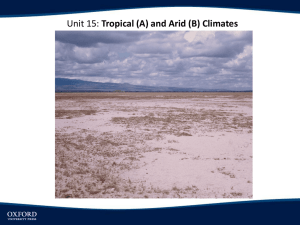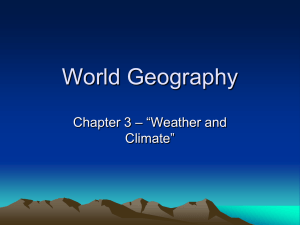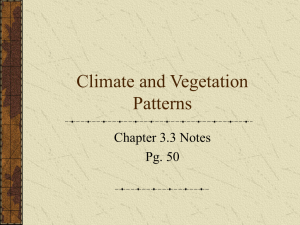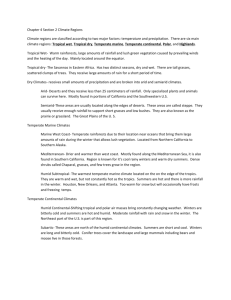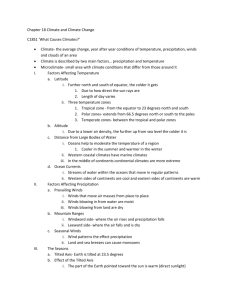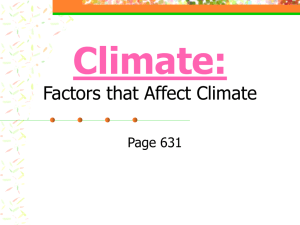File - Learning with Brooke
advertisement
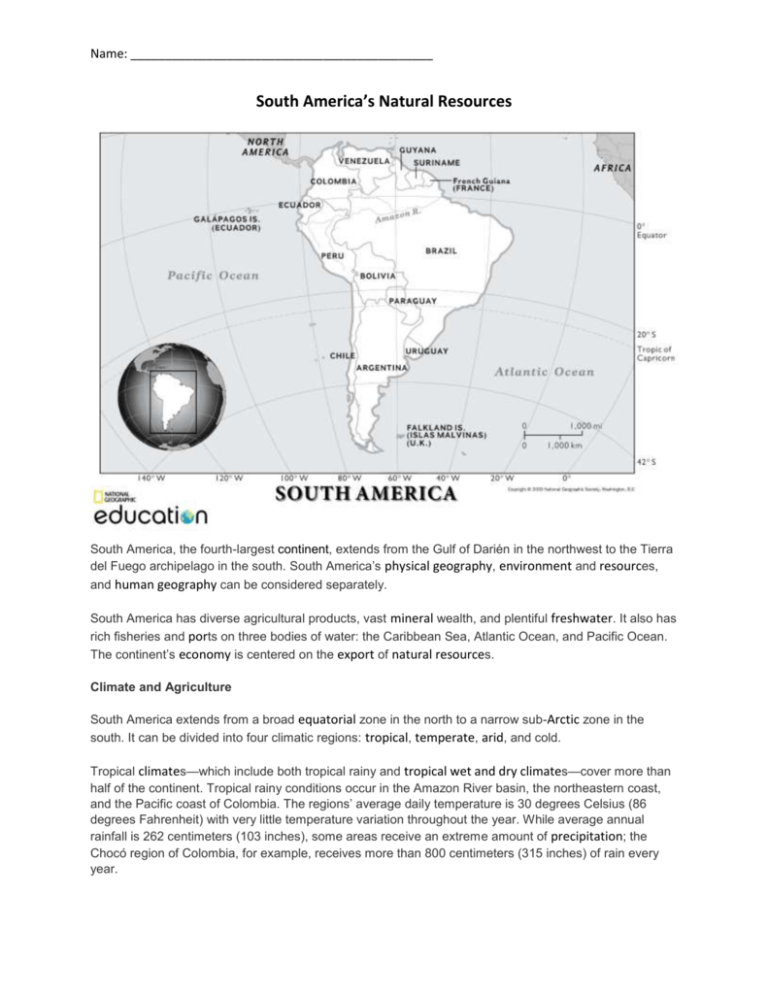
Name: ____________________________________________ South America’s Natural Resources South America, the fourth-largest continent, extends from the Gulf of Darién in the northwest to the Tierra del Fuego archipelago in the south. South America’s physical geography, environment and resources, and human geography can be considered separately. South America has diverse agricultural products, vast mineral wealth, and plentiful freshwater. It also has rich fisheries and ports on three bodies of water: the Caribbean Sea, Atlantic Ocean, and Pacific Ocean. The continent’s economy is centered on the export of natural resources. Climate and Agriculture South America extends from a broad equatorial zone in the north to a narrow sub-Arctic zone in the south. It can be divided into four climatic regions: tropical, temperate, arid, and cold. Tropical climates—which include both tropical rainy and tropical wet and dry climates—cover more than half of the continent. Tropical rainy conditions occur in the Amazon River basin, the northeastern coast, and the Pacific coast of Colombia. The regions’ average daily temperature is 30 degrees Celsius (86 degrees Fahrenheit) with very little temperature variation throughout the year. While average annual rainfall is 262 centimeters (103 inches), some areas receive an extreme amount of precipitation; the Chocó region of Colombia, for example, receives more than 800 centimeters (315 inches) of rain every year. Name: ____________________________________________ Tropical wet and dry conditions occur in the Orinoco River basin, the Brazilian Highlands, and in a western section of Ecuador. Temperatures are similar to tropical rainy, but have a greater daily range. There is also less precipitation and a prolonged dry season. Many crops thrive in the tropical climates of South America. Cashews and Brazil nuts are cultivated. Fruits such as avocado, pineapple, papaya, and guava are also native to tropical South America. Two very important cash crops are coffee and cacao, which is the source of cocoa, the base ingredient in chocolate. Brazil is the world’s largest exporter of coffee, and it used to be one of the largest exporters of cacao. In 2000, a fungus spread throughout many of South America’s cacao plantations, devastating the economies of the region and driving up the price of chocolate. The chocolate industries of Brazil, Venezuela, and Ecuador are slowly recovering, but most of the world’s cacao now comes from countries in tropical Africa. The continent’s temperate climates are located south of the Tropic of Capricorn and in the mid-level elevations of the Andes mountains. Temperate climates have a greater temperature range and lower winter temperatures than tropical climates. South America’s temperate climates are home to a number of industrial crops and livestock. Corn is produced throughout the temperate climates, and soybeans have become an increasingly lucrative crop in the Pampas. The Pampas’ vast, high-quality pastures are also the center of South America’s huge ranching industry. Brazil is the world’s third-largest beef exporter (behind only Australia and the United States). Argentina is also an important beef exporter. Arid climates are found in deserts, coastal areas, and interior regions throughout South America. Some of these climates are extremely cold, while others are extremely hot—but they all receive very little precipitation. This makes agricultural production difficult. However, heavily irrigated crops, such as rice and cotton, are grown in desert oases. Cold climates occur in the southern ends of Argentina and Chile and the highest elevations of the Andes. Cold climates have an average annual temperature of below 10 degrees Celsius (50 degrees Fahrenheit). These climates are characterized by long dry seasons and high winds. While these cold climates limit crop production, they are also home to thousands of native potato species and the native quinoa plant—a grain-like crop grown for its edible seeds. Potatoes and quinoa are starchy food staples of the Andean diet. Potatoes are now one of the biggest crops in the world. Ninety-nine percent of the potatoes grown throughout the world can be traced to a single species that was originally cultivated in the Chiloé Archipelago more than 10,000 years ago. In addition to potatoes and quinoa, grazing animals such as sheep, llamas, alpacas, and vicuñas also thrive in cold climates. These animals are bred for their meat and wool, which is used in highquality textiles exported throughout the world. Name: ____________________________________________ Forestry and Fishing Forestry is the management of trees and other vegetation in forests. It is a major economic activity for tropical South America, especially the Amazon River basin. Many high-value tree species, such as mahogany and rosewood, are native to the rain forest. Lumber from these trees is exported to foreign markets for use in cabinets and floors. Some countries have tree plantations. Chile, for example, is an important exporter of wood chips, plywood, and paper pulp. Lower-grade woods are important to the construction market in South America. The most familiar of these less-expensive woods is eucalyptus. Eucalyptus is not native to South America, but it grows at an incredibly quick rate. Eucalyptus is used as both a building material and as fuel in low-income communities throughout South America. Marine fisheries are the most important economic activity along South America’s Pacific coast, although overfishing has depleted many fish populations. The cold Peru Current brings nutrient-rich waters to the coast, creating a fishery with everything from whales to shrimp. Peru and Chile’s abundant anchovy catches are processed into fishmeal, an ingredient used in animal feed and fertilizer. Chile is a global leader in farm-raised salmon and trout, while Ecuador is an important shrimp exporter. Mining and Drilling The mining industry is one of South America’s most important economic engines. The continent contains about one-fifth of the world’s iron ore reserves. Iron and steel (an iron product) are used in construction and machinery throughout the world. More than one-quarter of the world’s known copper reserves are in South America, mostly in Peru and Chile. Valued at $26.9 billion in 2009, copper accounts for nearly one-third of the exports of Chile, the world’s largest copper exporter. Copper is used in electrical wiring and equipment because it is a good conductor of heat and is resistant to corrosion. Other important metal deposits include tin, used to solder metallic surfaces; lead, used in construction, batteries, and bullets; and zinc, used as an anti-corrosion agent. Brazil, Peru, and Bolivia are major producers of tin. Lead and zinc deposits are found primarily in higher elevations of Peru, Bolivia, southern Brazil, and northern Argentina. South America is home to some deposits of oil and natural gas, which are drilled for energy and fuel. Oil and gas extraction is the dominant industry of Venezuela, with major deposits found around Lake Maracaibo and the El Tigre region. The oil sector accounts for about one-third of Venezuela’s total gross domestic product (GDP). Name: ____________________________________________ Based on the information above, answer the following questions in complete sentences. Climate and Agriculture: 1. Describe the climate in South America. 2. What important cash crops are found in the tropical climates of South America? 3. What are the Pampas’? How do they contribute to economy of South America? 4. What is the climate like in the southern ends of Argentina and Chile? What crops and animals are prevalent in those areas? Forestry and Fishing : 1. Why is forestry a major economic activity for tropical South America? 2. How does the Peru Current impact fishing in South America? Mining and Drilling: 1. Identify the major natural resources that are mined throughout South America. 1. Describe how TWO of the above natural resources you listed have impacted South America.

